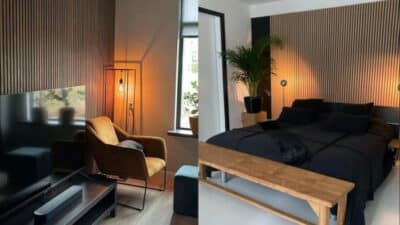

Creating a cozy interior means making a space feel warm, comfortable, and inviting. Simple choices like soft colors, layered textures, and gentle lighting can quickly transform a room into a relaxing retreat. These elements work together to build an atmosphere that feels both lived-in and welcoming.
Small changes can have a big impact, whether it’s adding plush pillows, arranging furniture for easy conversation, or bringing in natural touches like plants. Paying attention to details helps create a space that feels personal and calm without being cluttered.
Key Takeaways
- Warm colors and soft textures create comfort and depth in a room.
- Proper lighting and furniture layout enhance the inviting feel.
- Personal items and natural elements make the space unique and cozy.
Foundations Of Cozy Interior Design
Creating a cozy home starts with understanding what makes a space feel inviting and comfortable. Choosing the right elements for comfort, warmth, and balance helps to turn any room into a relaxing place. It also requires looking closely at the room’s size, light, and layout.
Defining Coziness In Home Decor


Coziness means more than just warmth. It is about creating a space that makes people feel safe and relaxed. Soft fabrics, warm colors, and natural light often help achieve this feeling.
Materials like wool, cotton, and linen add texture and softness. Using warm tones such as beige, brown, or muted orange promotes a calming mood. Adding elements like cushions, throws, and rugs brings physical comfort and a sense of welcome.
Key Principles Of Comfort


Comfort in interior design depends on a few key ideas. First, layers matter. Combining different textures and fabrics creates depth and warmth without clutter. Second, lighting needs to be warm and adjustable. Soft lamps or candles help avoid harsh brightness.
Furniture choice also plays a role. Pieces should be both functional and inviting. Chairs and sofas with soft cushions encourage relaxation. Lastly, spaces should avoid overcrowding, so there is room to move freely and enjoy the environment.
Evaluating Your Living Space


Before designing, it’s important to assess the room’s features. Look at natural light: is the room bright or dim? This affects color choices and lighting needs. Next, measure the size to understand which furniture fits without crowding.
Consider how the space is used daily. Different rooms need different comfort levels. A living room might need more seating, while a bedroom focuses on rest. Taking note of any odd shapes or corners helps in placing furniture and decoration to maximize warmth.
Choosing Warm And Welcoming Color Palettes
Warm and inviting color palettes create a comfortable feeling indoors. Using the right tones can make a space feel peaceful and relaxing. The choice of colors should balance natural warmth with softness and a few pops of friendly color.
Selecting Earthy Tones


Earthy tones like browns, terracotta, olive greens, and muted yellows add a natural warmth to any room. These colors remind people of nature and give a grounded feeling. They work well on walls, furniture, and accessories.
Using these tones helps create a sense of calm and connection to the outdoors. They pair nicely with natural materials like wood and stone. For example, a beige wall with terracotta accents can feel both warm and inviting.
Earthy colors are also versatile. They combine easily with other warm shades or soft neutrals, allowing for a cohesive look without being overwhelming.
Using Neutrals For Softness


Neutrals like cream, taupe, soft gray, and warm white bring softness to a space. They provide a gentle background that balances stronger earthy tones. Neutrals also make rooms look brighter and more open.
When used on walls and large furniture pieces, these colors keep the space feeling light and airy. Neutrals create a calm atmosphere without competing for attention with other colors.
Pairing neutrals with textured fabrics, like wool or linen, adds depth and coziness. This soft palette helps maintain a welcoming mood that feels easy on the eyes.
Accent Colors For Inviting Ambiance


Accent colors add personality and energy to warm palettes. Rich reds, deep oranges, mustard yellows, and soft blush tones work well to create a friendly vibe.
These colors should be used in smaller doses, like cushions, rugs, or artwork. This prevents the space from feeling too busy or intense. Accents draw the eye and add interest without overwhelming the calm base tones.
Strategic use of accent colors can highlight certain areas. For instance, a burnt orange throw on a neutral sofa immediately makes the seating area more inviting and lively.
Layering Textures For Depth And Comfort
Using different textures in a room adds visual interest and a sense of warmth. Combining soft fabrics, natural materials, and textured walls creates a layered look that feels inviting and lived-in.
Incorporating Plush Fabrics


Plush fabrics like velvet, chenille, and faux fur add softness and comfort to any space. These materials invite touch and create cozy seating or bedding areas.
Throw pillows, blankets, and upholstered furniture are good places to use plush fabrics. Mixing smooth and soft textures, such as a velvet cushion on a linen sofa, brings contrast and depth.
Choosing rich colors in plush fabrics can also enhance a room’s warmth. For example, deep blues or warm earth tones in velvet give a space a more intimate feel.
Mixing Natural Materials


Natural materials, including wood, stone, and wicker, provide texture that feels grounded and organic. They break up smooth surfaces and add tactile variety.
Using a wooden coffee table or wicker baskets offers a rugged contrast to soft fabrics. Stone elements, like a fireplace or decorative items, add cool texture to balance warmth.
Mixing these materials requires attention to scale and color. Light woods work well with airy spaces, while darker woods and rough stone suit rooms with deeper, warmer palettes.
Textured Wall Treatments


Walls with texture create depth without adding clutter. Options include plaster, wood paneling, shiplap, or textured wallpaper.
A plaster wall with subtle ridges or a shiplap wall painted in soft colors can make a room feel cozy and interesting. Textured wallpaper with a raised pattern adds tactility without permanent changes.
These treatments work best when balanced with simpler furniture and decor. Avoid overly busy wall textures in small rooms to keep the space from feeling cramped.
Maximizing Natural And Ambient Lighting
Good lighting can change how a room feels. Using daylight, lamps, and candles in the right way helps create a warm and inviting space. Lighting should make the room feel bright but soft, avoiding harsh shadows or glare.
Utilizing Daylight Effectively


Daylight is the best light source for a cozy room. It makes spaces feel open and fresh. To use daylight well, keep windows clean and clear of heavy curtains. Sheer curtains work best to let light in while keeping privacy.
Mirrors placed opposite windows reflect light deeper into the room. Light-colored walls and furniture also help bounce daylight around. Avoid blocking windows with large furniture so sunlight can spread freely.
Creating Soft Lighting With Lamps


Lamps add warmth when daylight fades. Choosing lamps with warm bulbs (2700 to 3000 Kelvin) helps create a cozy glow. Floor lamps and table lamps with fabric shades diffuse light softly.
Position lamps near seating areas or corners to brighten dark spots. Use dimmer switches to adjust brightness for different moods. Avoid single overhead lights alone, as they can feel harsh and cold.
Candlelight And Decorative Fixtures


Candles add a flickering, natural warmth that feels calming. Grouping candles in clusters on trays or shelves works well. LED candles are a safer, longer-lasting option but aim for a soft flicker effect.
Decorative fixtures like string lights and lanterns create patterns and shadows that add texture. Choose fixtures with warm tones or colored glass to amplify coziness. Use these lights as accent, not primary, sources.
Selecting Cozy Furniture Arrangements
Creating a warm space involves picking the right pieces and placing them carefully. Comfort, interaction, and flexibility are the main goals when arranging furniture.
Choosing Comfortable Seating


Comfortable seating means more than just softness. Chairs and sofas with good back support and soft cushions work best. Materials like cotton, linen, or soft leather feel pleasant.
Size matters too. Choose seats that fit the room without crowding it. Armrests and high backs add coziness and support. Adding throw pillows or blankets increases warmth and softness.
Durability is important. Look for furniture that holds its shape over time. A comfortable seat invites people to sit longer and relax.
Arranging Furniture For Connection


Furniture should bring people together. Arrange sofas and chairs to face each other or form a circle. This encourages conversation and eye contact.
Leave enough space between pieces to move easily but keep everything close enough for a sense of intimacy. Avoid pushing all furniture against the walls.
Using a rug to anchor the seating area helps create a defined space. Arrange furniture so it’s easy to access by all.
Utilizing Ottomans And Poufs


Ottomans and poufs add both comfort and function. They can act as footrests or extra seats when friends visit. Their soft surfaces keep the cozy feel.
Choose ottomans with storage to hide blankets or magazines. Poufs in warm colors add texture and a casual touch.
Place these pieces near seating to make the space flexible. They can be moved around to fit different needs, making the room more inviting.
Enhancing Warmth With Accessories
Warmth can be added to a room through simple, thoughtful choices. Using soft textiles and well-chosen rugs helps create a more inviting space.
Throw Blankets And Cushions


Throw blankets and cushions are key tools for warmth. Choosing blankets made from wool or fleece boosts softness and insulation. These fabrics hold heat well and feel comfortable against the skin.
Cushions add both style and comfort. Mixing different textures, like velvet and knit, creates visual interest while making seating areas cozier. Using warm colors like burnt orange or deep red helps enhance the sense of warmth.
It is important to layer these items. Stacking cushions or draping a blanket over a chair invites people to relax. Keeping blankets within easy reach encourages use during colder times.
Area Rugs For Added Comfort


Area rugs add physical warmth underfoot, especially on hard floors. Picking rugs with thick pile, like shag or wool, provides extra cushioning and insulation.
Size matters. Rugs that cover main walkways or seating zones define spaces and trap heat. This effect lessens cold drafts from floors.
Color and pattern choices impact the room’s ambiance. Earth tones and muted patterns often make a space feel calmer and warmer. Rugs can tie together furniture and accessories for a harmonious look.
Daily care, such as vacuuming and rotating rugs, keeps them plush and effective at warming a room over time.
Personal Touches And Meaningful Decor
Adding personal touches and meaningful decor makes a space feel lived-in and comfortable. These elements bring warmth and identity to a room. Thoughtful choices here create a deep connection to the space.
Displaying Family Photos And Artwork

Family photos and artwork add personality and history to a room. Photos in simple frames or small galleries can make walls feel warm and inviting. Grouping several pieces in a neat arrangement helps create a focal point without clutter.
Artwork should reflect the occupant’s style or memories. It can be something bought or homemade. Rotating artwork or photos lets the space feel fresh while keeping it personal.
Using shelves or ledges to display pictures allows easy changes and adds layers to the room’s design. Mixing photo sizes and frame styles adds visual interest but keeping a consistent color theme prevents chaos.
Incorporating Sentimental Objects


Sentimental objects like souvenirs, heirlooms, or handmade crafts bring unique stories into the room. Placing these items on shelves, mantels, or side tables highlights their importance.
These objects should be thoughtfully arranged, not overcrowded. Grouping them in odd numbers or by theme helps keep the look intentional.
A small collection of meaningful items can create emotional warmth and spark conversation. Including practical items with sentimental value, like a cherished blanket or a favorite vase, adds both function and feeling.
Integrating Greenery And Nature-Inspired Elements
Adding plants and natural materials can make a room feel warm and inviting. These elements bring life and texture to spaces without needing big changes.
Houseplants For A Cozy Feel


Houseplants improve air quality and add calm to a room. Popular options include spider plants, pothos, and snake plants because they need little care.
Placing plants at different heights, like on shelves or hanging baskets, creates visual interest. Small plants on tables or windowsills also brighten corners.
Using simple pots in neutral colors or natural textures keeps the look soft. Rotating plants to catch sunlight helps them stay healthy and vibrant.
Natural Materials In Decor


Choosing natural materials can add warmth and texture. Wood, stone, and cotton are common choices that fit many styles.
Wood furniture or accents bring an organic feel. Textiles like wool or linen add softness, especially in throws or pillows.
Using woven baskets or rattan pieces adds depth without clutter. These materials wear well over time and age nicely, keeping the space cozy.
Optimizing Small Spaces For Coziness
Making a small space feel cozy means being smart with how things are stored and choosing furniture that works more than one way. Using these ideas can help keep the room open and welcoming.
Smart Storage Solutions
Using storage that fits the space well is key to keeping a small room tidy and cozy. Shelves that go up the wall save floor space while giving plenty of room for books or decor. Baskets or bins under beds or sofas hide clutter but stay easy to reach.
Built-in cabinets or floating shelves work well because they don’t crowd the floor. Hooks on walls or doors can hold coats or bags without needing a bulky stand. Clear containers help find things fast while keeping them neat.
Tips for smart storage:
- Use vertical space with tall shelves
- Store items under furniture
- Choose storage that matches the room’s style
- Keep everyday items easy to reach


Multi-Functional Furniture
Furniture that serves more than one purpose is perfect for small spaces. Sofas that turn into beds let a living room become a guest room. Ottomans with hidden storage can hold blankets or toys.
Tables with drop leaves or that fold save space when not in use. Desks that double as vanities add function without extra furniture. Chairs that stack or fold keep the floor clear when guests come.
Ideas to try:
- Sofa beds for seating and sleeping
- Storage ottomans for seats and boxes
- Foldable tables and chairs for flexible space
- Desks that can be hidden or used for other purposes
Maintaining A Clutter-Free Environment


Keeping a space clutter-free is key to a cozy interior. Clutter makes rooms feel crowded and stressful, which works against a warm and inviting atmosphere.
They should start by sorting items into three groups: keep, donate, and toss. This helps remove things that are no longer needed or used.
Using smart storage solutions can help keep surfaces clear. Baskets, shelves, and boxes are great for organizing items out of sight.
Daily habits like putting things back in their place can stop clutter from building up. Spending just five minutes a day tidying makes a big difference.
It’s helpful to limit how much stuff comes into a space. Being mindful about purchases reduces future clutter.
To visualize the process:
| Step | Action | Result |
|---|---|---|
| Sort items | Keep, donate, toss | Clearer space |
| Use storage | Baskets, boxes | Organized, less mess |
| Daily tidy-up | Put things away daily | Maintains clutter control |
| Limit intake | Buy only what’s needed | Prevents new clutter |
- 145shares
- Facebook0
- Pinterest145
- Twitter0



